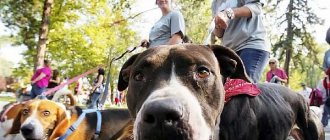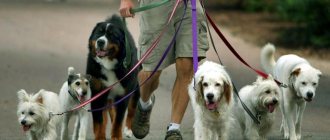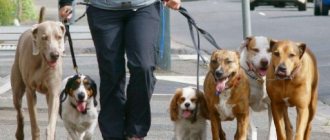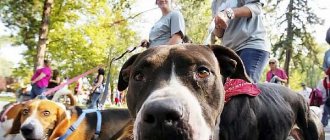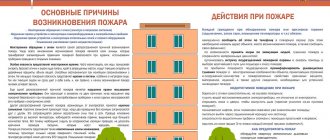The legislation of the Russian Federation protects pets and regulates the treatment of animals. The Dog Law defines the rules for walking and also provides for liability for violation. Before getting a pet, you should familiarize yourself with the basic legal requirements. After all, ignorance of the law does not exempt you from responsibility.
Review of current legal regulations
Owners are required to follow the rules for walking dogs, as well as ensure the safety of people around them, other animals, and prevent damage to property. Strict requirements regarding the mandatory wearing of a muzzle remain in relation to breeds that pose a potential threat.
When going for a walk with your pet, prepare the appropriate equipment. An animal of any breed (even a small and “safe”) one must have a leash and collar (belt). It is recommended to attach a tag to the collar indicating the owner's contact information.
Also, according to the law, you must clean up after the animal. Therefore, for a walk you need to take disposable bags and a small scoop.
It must be taken into account that changes in the legislative sphere are made not only at the national, but also at the local level. For example, an initiative group can organize pet walking on the territory of a closed residential complex. Residents often designate a separate walking area in the yard and also fine violators.
Pet Law
Important legislative acts in Russia regarding dogs are the following:
- Constitution of the Russian Federation.
- Federal Law No. 498-FZ.
- Sanitary and hygienic rules (VP 13.3.4.1100-96, VP 13.3.1103-96 and others).
Sanctions for violations provided for by Russian law are contained in the Code of Administrative Offenses of the Russian Federation and the Criminal Code of the Russian Federation.
Transportation rules
If the walk includes travel on public transport, the pet owner must comply with the rules established by the carrier. For example, some allow animals to be placed in a separate place in a cage. If there are no clear requirements, then in controversial situations the parties are guided by the national rules for the carriage of passengers.
The owner has the right to place the pet in a separate seat, while paying double the fare. If the transport is completely filled with passengers, it is recommended to transfer the dog to your lap (pick it in your arms, place it on the floor).
When boarding the aircraft, the owner must provide the following documents:
- veterinary certificate indicating which vaccinations have been received;
- certificate of the pet’s health status, issued at the veterinary clinic (with a note indicating when the last vaccination was carried out).
Requirements for ground transportation are not as strict. But in order to avoid controversial situations, it is better to always have the listed documents with you.
It must be taken into account that the rules for walking and transportation also take into account the weight categories of dogs. For example, individuals weighing no more than 5 kg can walk without a muzzle, and only aircraft charge for the transportation of such pets.
It is recommended to transport small pets in containers. Large dogs are usually placed in the back seats of vehicles.
The general rule for all breeds is this: the pet should not be allowed to move freely around the cabin and interfere with other passengers and the driver.
What breeds should not be kept in an apartment?
Current legislation does not establish a clear list of those breeds that are prohibited from living in apartments. But it contains a list of breeds that are dangerous and aggressive. These include:
- Fighting breeds: pit bull terrier, Staffordshire terrier, mastiv, alabai, bulldog, Caucasian shepherd dogs.
- Hunting breeds: huskies, griffins, retrievers, Azawakhs and Blandhounds. The corresponding breeds were bred specifically for hunting, which is responsible for their specific behavior and special content. They need maximum physical activity, which can become a problem when keeping them in an apartment.
- Guard breeds: Rottweilers, Dobermans, German Shepherds, Asian Shepherds, Bullmastiffs. The main purpose of breeding this type of dog is to perform service. Their animal instincts are heightened; in an apartment, such a dog may react inappropriately to the behavior of family members, so keeping them in an apartment building is not recommended.
- Herding breeds: collies, Central Asian and Australian shepherds, bobtails, boxers and mountain dogs. These breeds require long walking, regular training, as well as proper and plentiful nutrition. This category can react aggressively towards neighbors, family members and guests.
Rules for walking on dog parks
The legislation provides for the organization of separate areas for walking pets. For example, walking without a muzzle and a leash is allowed on areas that are marked with a special warning sign.
The following requirements apply to the walking area:
- area of at least 400 sq. m;
- the height of the fence to enclose the territory is at least 2 meters;
- the distance to children's and educational institutions is at least 40 meters;
- residential and commercial buildings must be located at least 25 meters away.
In addition, the coverage of the territory must be updated annually, and dog boxes must be installed within the site. The condition of the dog walking area is monitored by the local government.
You may also find the rules for walking dogs during a pandemic and self-isolation helpful.
Responsibility measures for the animal owner
Walking dogs on playgrounds and sports grounds is prohibited. To avoid getting a fine “accidentally”, it is better to walk your pets in specially designated areas.
Moscow has its own rules, according to which it is prohibited to involve children under 12 years old in walking pets (up to 14 years old if you need to walk a large breed, up to 18 years old - for walking fighting dogs).
You should not assume that liability occurs only if a dog damages someone else’s property or bites another person. Also, do not ignore the requirements for a muzzle and a leash if it seems that the dog is completely friendly and calm, and follows commands perfectly.
Judicial practice shows that pet owners often overlook force majeure factors. Anything can provoke a dog into aggressive actions: children playing, a bitch in heat, the smell of a drunk person. The owner is obliged to be vigilant, not leave the pet unattended, and not remove the dog’s muzzle in crowded places.
If the dog does not obey, contact a dog handler - in another article we told you how much such services cost.
At the same time, the law provides for liability not only for the actual damage, but also for the fact of the violation itself. Concerned citizens just need to record the violation in a photo or video and contact the relevant supervisory authorities.
The Law on Walking No. 498-FZ defines breeds that pose a potential threat to others. Walking such dogs without a leash and muzzle is strictly prohibited. If the owner neglected the requirements of the law and walking the dog without a muzzle led to harm to human health, then administrative liability develops into criminal liability. Archives of court cases show that it is quite possible to prove the guilt of a negligent owner.
When buying a fighting breed pet, you need to prepare not only for the fact that walking without a leash and muzzle will be prohibited. After all, the law regulates not only the rules for staying with an animal in public places, but also the conditions of detention.
For example, fighting dogs are not allowed on some sites at all. Uncontrolled walking is prohibited. You will have to walk your pet within a private fenced area. But it is prohibited to appear in public recreation areas and forest belts.
Important! It is necessary to hang a warning sign (plate) if there is a dog on private property whose breed is included in the list approved by the Government of the Russian Federation.
Rules of claim proceedings
A claim for violation of silence is filed with the district court at the place of registration of the violator. Reviewed within 2 months from the date of registration of the application.
How to file a claim
The statement of claim is drawn up according to the provisions of Art. 131 Code of Civil Procedure of the Russian Federation indicating:
- Names of the court.
- Details of the plaintiff.
- Details of the defendant.
- Fact of violation of rights.
- The plaintiff’s demands indicating legal norms;
- The circumstances on which the claims are based with evidence;
- Cost of the claim;
- Actions taken to resolve the conflict pre-trial;
- List of attached documents.
Required evidence
The more evidence is presented to the court, the higher the likelihood of a decision in your favor. The following must be attached to the claim as supporting rules:
- Audio/video recordings of a barking dog indicating the time, as well as conversations with the owner with a proposal to solve the problem peacefully.
- Testimony from neighbors.
- Documents confirming attempts to resolve the conflict pre-trial.
Amounts of fines, terms of restriction of freedom
You should know that criminal prosecution of an owner who allowed a dog to walk without a muzzle and a leash is only possible if the pet maimed another person. The owner is being tried for causing grievous harm by negligence. The measure of liability is established by Art. 118 of the Criminal Code of the Russian Federation.
The culprit faces a fine of up to 80,000 rubles or the collection of wages for six months.
A citizen can also be sent to compulsory labor (maximum 480 hours) or correctional labor for up to 2 years.
Possible placement under house arrest for up to 6 months.
The most severe punishment is restriction of freedom for 3 years.
If the violation occurred due to the fault of an official who was on duty (serious harm was caused by a service dog), the punishment is increased. The exception is cases when a service dog caused harm to a criminal who resisted during arrest.
Even if the dog did not cause serious injury, the victim can go to court to recover an amount to cover moral damages. In accordance with paragraph 1 of Art. 1085 of the Civil Code of the Russian Federation, the pet owner is also obliged to compensate for the material damage caused.
This also applies to the amount of lost income (for example, if the victim missed work due to a dog attack). The amount spent by the victim on medical care must also be compensated.
Where to complain and instructions
If breeders do not comply with the requirements of current legislation, citizens have the right to complain to the local administration or district police officer.
Attention! When submitting an application, it is recommended to attach documentary evidence that the dog owners do not comply with the prescribed rules. This could be photographs, videos, witness statements and more.
Lawyers recommend drawing up collective complaints, to which district police officers or officials from the local administration respond more quickly. The application must be written in two copies. It is recommended to indicate the addressee in the complaint (the head of the administration or the name of the district police officer).
Punishment for walking animals in the wrong place
An owner who violates the rules for walking a pet is liable under the Code of Administrative Offences. Since the fine for a dog is determined by local authorities, the amount differs depending on the subject of the Russian Federation in whose territory the offense was recorded.
Examples of violations and penalties:
- keeping a pet without a leash within a recreation area or forest belt (1–2 thousand rubles);
- walking on the playground (same amount);
- transportation in public transport without ammunition (from 500 to 1000 rubles);
- visiting a retail outlet with a dog without a muzzle and a leash (1–2 thousand rubles);
- keeping an animal without the consent of neighbors in communal premises (2 thousand rubles);
- organization of dog fights (2.5 thousand rubles);
- setting a dog on a person (5 thousand rubles);
- servicing a dog’s natural needs in areas where walking is prohibited (1–2 thousand rubles);
- walking a pet by a person who is intoxicated (5 thousand rubles).
The fine for walking a dog may be increased if the offense is registered again.
The legislative framework
The Federal Law on the Responsible Treatment of Animals takes into account the rules of behavior and treatment of a pet, the rights and responsibilities of the owner of a particular breed of dog.
The law is based on treating your pet with respect. The owner must perceive him as a creature who can be scared and in pain and who claims to be treated appropriately and have his needs met.
The law defines the owner as the owner or other person who keeps a pet. At the same time, the rules for dog breeds that are potentially dangerous are prescribed in a separate paragraph.
Monitoring compliance with these regulations is carried out by any organizations or unions that take on such responsibility. A list of such organizations can be found on the local government website.
